

Personalized Learning Through Project-Based Music. By Michael Hayden Project-based music is a way for students to personalize their learning, take ownership, use relevant technology, build upon and acquire new skills, and showcase their understanding to key learning outcomes—and yes, solve a real world “problem.”
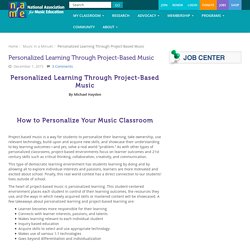
As with other types of personalized classrooms, project-based environments focus on learner outcomes and 21st century skills such as critical thinking, collaboration, creativity, and communication. This type of democratic learning environment has students learning by doing and by allowing all to explore individual interests and passions, learners are more motivated and excited about school. Finally, this real world context has a direct connection to our students’ lives outside of school. What is the Difference Between Problem, Project, and Challenge Based Learning?
Personalized Learning Through Project-Based Music - NAfME. In PBL, the Problem is the Project - Pbl Global. When I worked for the Buck Institute for Education in the early 2000’s, we held endless staff meetings probing the distinction between project based learning and problem based learning.

It was a necessary discussion at that point in the evolution of PBL. Many of BIE’s early offerings centered around problem based units in Economics, and no adequate definition of PBL itself had emerged. That debate has faded into history because BIE offered a settled definition of PBL that has stuck. It’s a “teaching method in which students gain knowledge and skills by working for an extended period to investigate and respond to an authentic, engaging and complex question, problem, or challenge. But the debate also lost steam because the staff ended up dancing on the head of a pin. And yet, somewhere in the intervening years, PBL has begun to lose the problem-solving focus. Advocates of high quality PBL should hold their applause, however.
That’s a danger for PBL–and teachers know it. Project Based Learning: Start Here. DRIVING QUESTION LIST. Project Based Learning. Making Projects Click. Top Project Based Learning Lesson Plans. About ETR Community EdTechReview (ETR) is a community of and for everyone involved in education technology to connect and collaborate both online and offline to discover, learn, utilize and share about the best ways technology can improve learning, teaching, and leading in the 21st century.
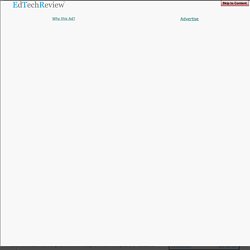
EdTechReview spreads awareness on education technology and its role in 21st century education through best research and practices of using technology in education, and by facilitating events, training, professional development, and consultation in its adoption and implementation. Teaching with Technology Series - Grade 3, English Language Arts. NTN Project Quality Checklist. How You Can Bring Creativity Back Into Your Classroom With Project Based Learning. Think about it: when was the last time a creative task held your focus?
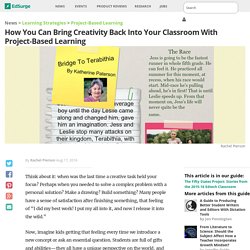
Perhaps when you needed to solve a complex problem with a personal solution? Make a drawing? Build something? Many people have a sense of satisfaction after finishing something, that feeling of “I did my best work! I put my all into it, and now I release it into the wild.” Now, imagine kids getting that feeling every time we introduce a new concept or ask an essential question. According to a study from Adobe (which an accompanying infographic shown to the right), 82% of college-educated professionals wish they had more exposure to creative thinking as students. But where to begin?
Teacher Sets the Standards, Student Chooses the Project As you get ready for the new 2016-2017 school year, you wonder—where does one start? When Tech Meets Project Based Learning. Almost 20 years ago, when Paul Curtis was a social studies teacher at the just-opened New Technology High School in Napa, Calif., there wasn’t much “tech” to support project-based learning.

“We didn’t even give the kids email addresses back then,” he chuckles. Even now, Curtis, Director of Curriculum for the New Tech Network, is confident that project-based learning can happen without much technology. But use it right, he adds, and technology can change the “tone” of the classroom in powerful ways. “It asks teachers to give up ‘the script’ for the classroom,” he says. Resources for Assessment in Project-Based Learning. Project-based learning (PBL) demands excellent assessment practices to ensure that all learners are supported in the learning process.
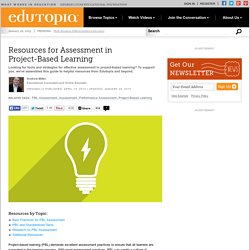
With good assessment practices, PBL can create a culture of excellence for all students. We’ve compiled some of the best resources from Edutopia and the web to support your use of assessment in PBL, including information about strategies, advice on how to address the demands of standardized tests, and summaries of the research. Best Practices for PBL Assessment Assessment in Project-Based Learning (Buck Institute for Education, 2014) In this recorded Google hangout, BIE’s John Larmer and a panel of educators address the driving question, "How can we effectively assess student learning in PBL? " Resources for Getting Started with Project-Based Learning. Just getting started with project-based learning (PBL)? Our curated list of resources for educators new to PBL should help you. Before you get started, be sure to check out Edutopia's PBL page, including information about the research behind effective PBL practices.
You can also connect with Edutopia's community to learn and share PBL tips. Integrated PBL Projects: A Full-Course Meal! In the project-based learning field, we use the metaphor that projects are the "main course, not the dessert" (as coined in an article from the Buck Institute for Education).
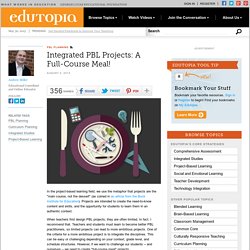
Projects are intended to create the need-to-know content and skills, and the opportunity for students to learn them in an authentic context. When teachers first design PBL projects, they are often limited. In fact, I recommend that. Teachers and students must learn to become better PBL practitioners, so limited projects can lead to more ambitious projects. One of the criteria for a more ambitious project is to integrate the disciplines. 24 Project Ideas from Global Digital Citizenship Foundation. Project Based Learning in the Classroom: Project Ideas Year 10-12 includes projects with these driving questions: What goes into training and improving the performance of a professional athlete?
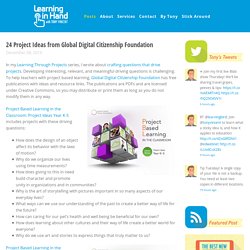
Why are creative minds and critical thinkers so crucial to the evolution of our way of life? What does it take to turn your passion into a business? How can we show the parallel between modern life and the lives of characters in classic works of literature? How would understanding the function of our planet’s core help us to become more environmentally friendly? Problem-Based Learning or Just Another Project? Use This Checklist to Find Out. A few days ago I posted Amy Mayer’s comparison between assigning projects and developing project-based learning in the classroom.

Due to its immense popularity, I decided to do some more research on helpful charts for teachers trying to implement PBL in their classrooms, and was thrilled to come across this checklist from the good folks at BIE: This checklist is a fantastic way to ensure that you are on the right track with shifting away from “doing a project” and moving towards project-based learning. 42 Fill-in-the-Blank Prompts For Students To Design Their Own Projects. 42 Fill-in-the-Blank Prompts For Students To Design Their Own Projects by Terry Heick So often, we make learning more complicated than it has to be.
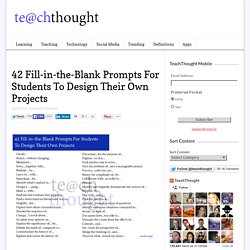
Local planning requirements are usually at fault here–plan this way and prove that you’ve done so here and here, fill out this and this, etc. Those legitimate concerns aside, the following series of fill-in-the-blank prompts can be used by teachers to create lessons, students to create projects–or teachers to collaborate with students to create lessons–or projects. 8 Steps To Design Problem-Based Learning In Your Classroom. What Is Problem-Based Learning? By TeachThought Staff What is problem-based learning? One definition, if we want to start simple, is learning that is based around a problem. That is, the development, analysis, and thinking towards a problem drives student learning forward.
We’ve been meaning to write a kind of beginner’s guide/primer to problem-based learning for, oh, about 18 months now and haven’t yet, so Mia MacMeekin’ss graphic here is going to have to do. The graphic eschews Mia’s usual squared, grid approach for something a bit more linear and comprehensive–an 8-step sequence to designing problem-based learning in your classroom. 12 Timeless Project-Based Learning Resources. 12 Timeless Project-Based Learning Resources by Shannon Dauphin Project-based learning is becoming increasingly popular as teachers look for a way to make lessons stick in the minds of their students. According to Edutopia, studies have shown that students who use project-based learning remember the material much longer and have healthier attitudes toward education.
A Project-Based Learning Cheat Sheet For Authentic Learning. A Project-Based Learning Cheat Sheet by TeachThought Staff Like most buzzwords in education, “authenticity” isn’t a new idea. For decades, teachers have sought to make student learning “authentic” by looking to the “real world”–the challenges, technology, and communities that students care about and connect with daily. You’ve probably been encouraged in the past to design work that “leaves the classroom.” Reach beyond the school walls. Project Based Learning Checklists.
Classroom Guide: Top Ten Tips for Assessing Project-Based Learning (now available in Spanish!) Facebook Edutopia on Facebook Twitter Edutopia on Twitter Google+ Pinterest. PBL Research Review (Edutopia) Editor's Note: This article was originally written by Vanessa Vega, with subsequent updates made by the Edutopia staff.
Twenty Ideas for Engaging Projects. The start of the school year offers an ideal time to introduce students to project-based learning. By starting with engaging projects, you'll grab their interest while establishing a solid foundation of important skills, such as knowing how to conduct research, engage experts, and collaborate with peers. STEM MI Champions: Leading Project-Based Learning / PBL Gallery. Home | Getting Started | Modules | Resources | About Us View the work of teachers who developed and implemented PBL units/mini-units. Making Projects Click. Project Based Learning. Six Engaging End-of-Year Projects. I don't know about your students, but so many of mine, coupled with Senioritis, were done after state testing. (The well had run dry, no blood from a turnip -- all those sayings applied!) With just a few precious weeks left in the school year, what do you do to keep the kids energized and on board with learning?
One thing I knew for sure when it came to my high school students: They had to feel as if they weren't actually doing work. (Yep, I had to trick them.) And whatever you do plan, especially for secondary students, three elements are essential: choices, creativity, and constructing. Why We Changed Our Model of the “8 Essential Elements of PBL” Project Based Learning: Don’t Start with a Question. A World of Project Ideas (You Can Steal) One of the advantages of project-based learning is the flexibility. PBL is an effective instructional strategy within individual content areas as well as across disciplines. It's engaging for young learners and teens alike.
Good projects can be short term and tightly focused, or expansive enough to require months of inquiry. How to Reinvent Project Based Learning to Be More Meaningful. By Thom Markham This is a crucial time for education. Every system in every country is in the process of figuring out how to reboot education to teach skills, application, and attitude in addition to recall and understanding. 3 Types Of Project-Based Learning Symbolize Its Evolution. Using Google Classroom to Support PBL. Project & Problem based Learning.
Six Steps for Planning a Successful Project. Project & Problem based Learning. What the Heck Is Project-Based Learning? EdWeb Wrap Up: The Epic Guide to Student Engagement - Learning Bird. 6 Strategies for Differentiated Instruction in Project-Based Learning. PBL Resources. Online Learning. What the Heck Is Project-Based Learning? Trello. Project Based Learning: Explained. Project Based Learning: Explained. 8 Essential Elements of Project Based Learning. Project Based Learning / Project work.